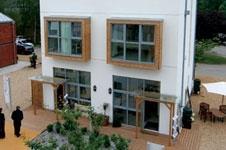Getting a good rating under sustainable building codes such as BREEAM needn't be a headache if you are foresighted and well organised
Councils, housing associations, landowners and developers are increasingly asking for assessments to be carried out on their developments. Typically used standards are the Code for Sustainable Homes for new residential, Ecohomes for refurbished residential and BREEAM for everything else. These tools can be extremely useful, providing a structure for tackling sustainability issues and a handy guide on design and build considerations.
But carried out badly, this process can result in too many meetings, extra expense, delays and even legal proceedings if the required rating is not achieved. So what can you do to make sure that it is a straightforward and successful process?
1. Start early
This is vital, for several reasons. A few tweaks to the early design can make many requirements easier to comply with. Other actions, such as consultation with the local community and whole-life costing, must be considered at an early feasibility stage in order to comply. And others still – particularly relating to site ecology – will be unachievable if work has already started on site. So appoint an assessor early to ensure that you know exactly what is required of the design team. We recommend doing this before RIBA stage D. Doomed is the assessment that starts too late…
2. Appoint responsibility
If the assessor is appointed early enough, compliance requirements can be costed for inclusion in the tender documents of each design team member. This ensures that everybody knows what they are responsible for and, hopefully, will avoid bickering at design team meetings over who needs to do what.
3. Hold regular updates
Once the assessor has been appointed and everybody in the design team knows their responsibilities, keep the assessment on the agenda: regular updates from the team ensure that requirements are not conveniently forgotten about. In addition, get the assessor to attend periodic meetings to review the design and keep the assessment on track. Finally, if any significant design changes are made, make sure that the assessor is notified. It is no good removing the solar thermal panels and then being surprised when the assessed building scores worse than anticipated.
4. Make evidence collection easy
Both the Code for Sustainable Homes and the latest version of BREEAM (released last August) require that the formal assessment happens in two stages: first a design stage assessment, carried out once the design is finalised (RIBA stages E-K) and second a post-construction review (RIBA stages K-L). At each stage the assessor must collate a range of detailed information, to be provided by the design team, demonstrating that all requirements have been met. This typically includes plans, specifications, reports and appointment letters. Co-ordinated poorly, this can be onerous and time consuming, so make sure that the assessor provides clear information on exactly what is required and who is responsible for providing it. In many instances, a simple signed letter from the project manager confirming compliance with the requirements may be sufficient, so do this where possible.
5. Don't cheat!
Both the Code for Sustainable Homes and BREEAM 2008 require that a post-construction review be carried out, so absolutely no corners can be cut. The assessor will need to carry out at least one site visit to ensure that everything matches up with the design stage assessment. And if the completed building does not comply, the required rating may be lost. This can seriously jeopardise and delay completion and may be very costly to rectify.
Postscript
David O'Rorke is an assessor at sustainability consultants



























1 Readers' comment